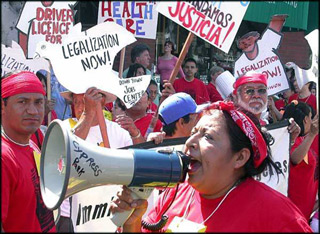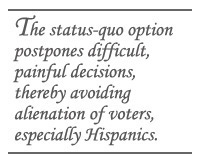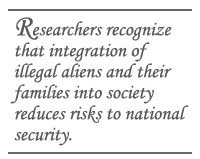12 Million Shadows: America’s Immigration Dilemma
12 Million Shadows: America’s Immigration Dilemma

NEW YORK: As the US presidential campaign grinds on policymakers debate what should be done about the estimated 12 million illegal aliens – mostly Hispanic, with nearly 60 percent from Mexico and 25 percent from Central America and the Caribbean – residing in the US. Broadly speaking, four possible options, each with several variants, are available.
At one extreme is the option granting legalization. This option, sometimes referred to as amnesty, allows illegal aliens to remain in the country legally and then eventually, with the necessary screening, tests, fines and fees, to have the opportunity to become US citizens. Among the top five US presidential candidates, four favored this option: Senator John McCain co-sponsored and both senators Hillary Clinton and Barack Obama as well as Governor Mike Huckabee supported the unsuccessful Bush-backed immigration-reform legislation, which among other things, would have provided a legal path to citizenship for illegal immigrants.
The legalization option was achieved in the recent past under the strong support and leadership of President Ronald Reagan. In 1986, the US granted nearly 3 million illegal aliens legalization or amnesty, with the intention that such opportunity would be the country’s last.

Many argue that legalization is a mistake because it rewards illegal immigration, undermining the rule of law; invites others to enter the country illegally; and keeps pressure on the borders. Public-opinion polls in recent years reveal that a large majority of Americans do not want to make it easier for illegal aliens to become citizens.
At the other extreme is the option to repatriate illegal aliens, an option that involves millions of illegal aliens deciding to return home on their own as well as government authorities sending them back involuntarily. In contrast to the other leading US presidential candidates, Governor Mitt Romney’s position was closest to the repatriation option. He condemned the recent immigration-reform legislation, opposed allowing illegal aliens to gain legal status in the country apart from existing procedures available to all non-citizens, and opposed President Bush’s proposed guest-worker plan.
While the government could certainly repatriate some illegal aliens, would millions voluntarily decide to leave? Some argue that consistent, across-the-board enforcement of immigration laws, such as verification of workers’ legal status, worksite enforcement, sanctions against employers who knowingly hire illegal aliens and cut-off of federal and state benefits, except emergency, would shrink the number of illegal aliens as they give up and deport themselves. In addition to quickly returning any illegal aliens caught at the border, strong law enforcement would remove opportunities for employment and social services.

The repatriation option – except when illegal aliens are captured near the border or commit serious crimes – is not being seriously considered by most political leaders in Washington. Homeland Security Secretary Michael Chertoff, for example, suggests that it’s simply impractical to deport the millions of foreigners present in the country illegally: “The cost of identifying all of those people and sending them back would be stupendous. It would be billions and billions of dollars.”
The third option is a kind of compromise between legalization and repatriation. It proposes to issue temporary guest-worker permits to illegal aliens holding jobs for a fixed period of time, e.g., six years, after which they would return to their home countries.
Here again, the majority of the American public opposes the guest-worker option, many because they see it as “back-door amnesty.” Also, many express skepticism about the chances of guest workers returning to their homes at the end of the period and expect that these workers will simply stay and end up as illegal aliens again.
The fourth option is maintaining the status quo. Under this option illegal aliens retain their current “illegal” status. Except at the borders, little law enforcement would be taken against illegal aliens or their employers. In other words, the estimated 12 million illegal aliens living in the US would not be repatriated to their home countries, but would continue to work, live and raise families in the US under an ambiguous status.

For now, legalization does not appear to be an acceptable option for much of the American public as well as many elected officials. Similarly, repatriation does not seem to be a viable option. In addition to the Bush administration and many in Congress, businesses, religious institutions, trade unions and special-interest groups oppose the repatriation of millions of illegal aliens. Given the strong opposition to both legalization and repatriation, some have backed a guest-worker program. But here again, public opinion is not enthusiastic about such a program, especially in light of the current economic slowdown and uncertainties in the financial markets.
All that remains then is the status-quo option. Clearly, this is politically advantageous, at least in the short run. It postpones difficult, painful decisions, thereby avoiding alienation of voters, especially Hispanics who count for a third of the population in California, a quarter in Arizona and some 15 percent in New York and New Jersey, or offending powerful special-interest groups, especially in a presidential-election year.
In the months ahead, especially after the election of a new US president, considerable debate, much of it acrimonious, will likely take place, with protests and possibly some civil disorder occurring. Also, during this period, the population of illegal aliens will continue to grow, becoming increasingly distributed geographically across the country as well as progressively more integrated within various economic, social, cultural and political sectors of US society.
Given experience of the recent past, arriving at a politically acceptable solution to the presence of millions of illegal aliens will likely be a difficult and time-consuming undertaking. At the least, it requires reaching a consensus that takes into account economic, social, cultural and political factors relating to the presence of large numbers of illegal aliens. Such interests cover a broad range of critical issues, such as justice, law and constitutional order; social cohesion, integration and national unity; economic growth, wages and labor-force needs; demographic changes; environmental concerns; human rights and responsibilities; compassion and decency. Likewise, consensus requires a balance among many competing foreign groups and affairs, national security and the US image abroad.
In the long run, however, three issues – demographics, economic interests and national security – will come to dominate the political debate. The overwhelming bulk of future US population growth – some 80 percent by mid-century – will come from immigrants and their descendants. In addition, increasing proportions of the country’s future population will be of Hispanic origin, reaching nearly 25 percent of the population by mid-century.

Researchers and policymakers increasingly recognize that the integration of illegal aliens and their families into American society reduces risks to national security. Not surprisingly after 9/11, government authorities wish to bring illegal aliens out of the shadows and into a regulated system. By so doing, they can better assess possible criminal backgrounds and security risks of illegal aliens residing in the country. Also, government policies aim to continue fully integrating the children of illegal aliens, many US citizens, and avoid creating an underclass of frustrated and angry youth, as has been witnessed in a number of European countries.
Simply stated, too many future voters are at stake, too much money and economic interests are involved, and too many security risks are at play for drastic changes in immigration policy. These powerful forces all point to the only viable long-term option for addressing the presence of the 12 million illegal aliens residing in the US: legalization.
Joseph Chamie is research director at the Center for Migration Studies.